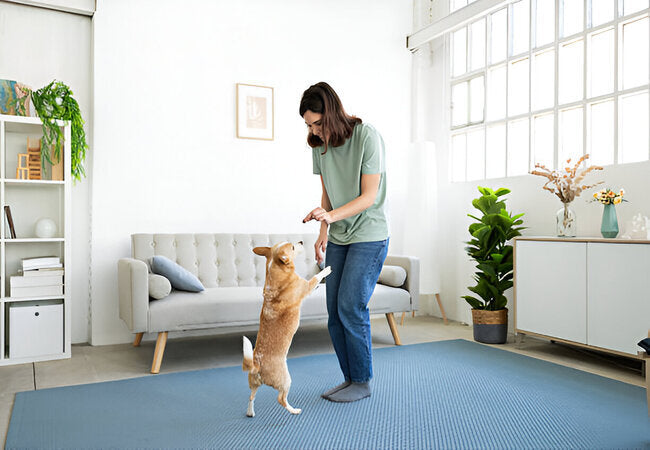Vet‑Approved 2025: Confidence‑Building Exercises for Timid Dogs 🐶💪

In this article
Vet‑Approved 2025: Confidence‑Building Exercises for Timid Dogs 🐶💪
By Dr. Duncan Houston BVSc
Timid dogs aren't broken—they're often reacting to past experiences or genetics. In 2025, vets highlight structured confidence-building through **gradual exposure**, **reward-based training**, and engaging **confidence‑boosting games**. This guide offers a compassionate, step-by-step roadmap to help your shy companion flourish with trust, joy, and assurance. 🐾✨
🧠 The Science of Confidence Building
Fear in dogs often stems from under-socialization or negative associations during critical periods (7–14 weeks). Through **desensitization + counterconditioning**, we replace fear-heavy associations with positive ones.
- Expose the dog to mild levels of the trigger (e.g., distant noise, calm stranger).
- Pair exposure with high-value treats immediately when the dog remains calm or shifts attention to you.
- Gradually increase exposure only as confidence grows.
🎮 Confidence-Building Activities & Games
1. Hide & Seek / “Find the Treat”
Scatter treats or hide toys to tap into natural scenting abilities—success builds pride and focus.
- Begin with obvious locations, then increase difficulty.
- Celebrate every find with enthusiastic praise and treats.
2. Targeting & Touch Games
Train your dog to touch your hand or an object—this empowers them to actively participate in challenges.
- Mark small successes (“yes!” + treat), reinforcing initiative.
- Encourage exploration and problem-solving in their own time.
3. Mini Agility & Obstacle Play
Use low tunnels, steps, or cones for gentle agility training—physical mastery builds mental confidence.
- Guide them through obstacles with treats, marking success.
- Increase challenge gradually, based on their pace.
4. Nose Work & Sniff Walks
Encourage sniffing-focused walks to allow self-paced exploration—great for stress relief and empowerment.
- Hide scented items along a walking route.
- Reward calm discovery and confident exploration.
5. Pool of Praise – Even Small Wins
Simply praising calm behavior in the face of triggers (quietly passing strangers, novel surfaces) helps sustain progress.
- Each little choice matters—reward focus over fear.
- Use calm tone and gentle touch to reinforce security.
🛠 Desensitization & Counterconditioning in Practice
Follow the simple “under-threshold” model:
- Identify the stimulus (bell, stranger, lawn mower, etc.).
- Find a distance/volume low enough the dog doesn't react fearfully.
- Pair stimulus presentation with immediate treat & praise for calm behavior.
- Gradually adjust the intensity or proximity as long as the dog remains relaxed.
- If fear signals appear (tail tuck, lip lick, yawning), increase distance and slow down progress.
📋 Sample Confidence-Building Routine
| Time | Activity | Goal |
|---|---|---|
| Morning | “Find the treat” around the house | Start day with empowerment |
| Midday | Sniff walk in park | Self-paced exploration |
| Afternoon | Desensitize to vacuum sound | Build calm response |
| Late afternoon | Mini agility play | Physical mastery & fun |
| Evening | Quiet targeting game | End on focused calm |
💡 Vet & Expert Insights
- Dr. Sarah Wooten, DVM: Start at a distance where fear doesn’t occur, reward calm, and repeat gradually.
- PetMD & Hepper affirm that games like hide‑and‑seek and agility build confidence and reduce anxiety.
- VeterinaryPartner recommends sniff walks, structured play, and gentle desensitization for fearful dogs.
- Reddit trainers: "Spend time, stay calm, reward incremental progress. Let the dog choose pace".
🚧 Common Roadblocks & Solutions
- Too intense stimulus: Back off. Only increase when the dog shows calm interest.
- No interest in game: Find a high-value motivator—cheese, chicken, toy.
- Fearful displays return: Reassess schedule; add more calm reinforcement, or consult a behaviorist.
- Plateaus: Change game style—introduce new challenges to keep engagement fresh.
📱 Ask A Vet App 2025 Support
- 📹 Expert video review of your dog’s progress, body language, and environmental setup.
- 🧩 Customized game plans & gradual exposure protocols tailored to your dog’s temperament and triggers.
- 💬 Live coaching during early sessions—real-time help managing pacing, intensity, and timing.
❤️ Final Thoughts
Every timid dog is a potential success story. With structured games, graduated challenges, and constant, gentle encouragement, a fearful pup can blossom into a confident companion. In 2025, vet-approved confidence-building means kindness, patience, and celebration of small victories—together building a bond defined by trust and joy. 🐶✨
Want printable routines, challenge trackers, or desensitization charts? Visit AskAVet.com or download the Ask A Vet app for expert-vetted plans, video feedback, and real-time coaching—empowering timid dogs one positive step at a time! 🐾






